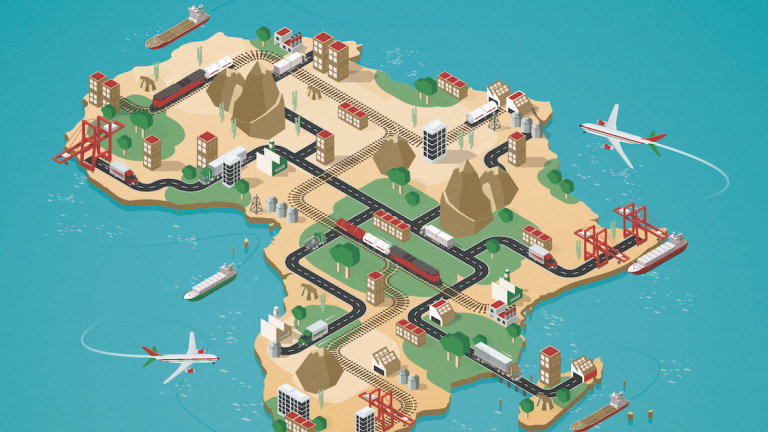
Unlocking Tunisia’s unexploited export potential
The African Continental Free Trade Area (AfCFTA) offers huge potential for Tunisia to grow its trade with the rest of Africa and reduce its dependence on the European market.
Trading with Europe, not Africa
The European Union (EU) has long been Tunisia’s leading trade partner. Bilateral trade increased sharply after Tunisia and the EU signed an Association Agreement in 1995 aimed at creating a free trade area for goods, excluding agricultural and fishery products. Between 2013 and 2017, four EU countries – France, Italy, Germany and Spain – received 60% of Tunisia’s exports. Main exports were textiles, machinery, transport equipment and extractives. If we exclude Libya and Algeria, Tunisia’s neighbours and strategic partners, only 5% of Tunisia’s exports went to African countries during that period. This is a very low share, particularly considering the country’s potential.
Finding new trade partners
The 2011 outbreak of political conflict in Tunisia and in the region put the Tunisian economy under pressure. The economy was already crippled by high unemployment, particularly among young graduates. This was compounded by the effects of the ongoing conflict in neighbouring Libya, which was Tunisia’s second biggest trade partner prior to 2011. Tunisia suffered a further loss of competitiveness when unrest and political instability arose within its own borders.
To diversify its trade partners, Tunisia has explored new markets, particularly in Africa. In 2017, it obtained observer status in the Economic Community of West African States (ECOWAS). It signed the African Continental Free Trade Area (AfCFTA) Agreement in 2018 and it officially joined the Common Market for Eastern and Southern Africa (COMESA) in 2019. These actions demonstrate Tunisia’s commitment to closer ties with the rest of Africa.
Redistribution or expansion of trade partners?
The AfCFTA will open up tremendous opportunities for African trade. A 2017 study by the United Nations Economic Commission for Africa (UNECA) predicted that African countries would see their exports rise by 2.7% (US $8.9 billion) in 2020, after removal of tariffs on trade in goods. Intra-African trade was set to expand by US $70 billion in 2020. A fifth of this gain (US $13.6 billion) was expected to go to North African exporters, with half that growth coming from expansion of trade within North Africa. The rest was expected to come from increased North African exports to other African countries.
Despite the numerous trade opportunities that the AfCFTA will bring for Tunisia, there is ongoing debate as to whether the agreement will create new trade with new partners or simply divert existing trade away from traditional (especially European) markets. For example, the UNECA study suggests that the AfCFTA will lead to a US $4.7 billion drop in North African exports to the rest of the world. However, the proposition that existing trade will merely be redistributed assumes a limited supply capacity. This is not the case in Tunisia, which has high unexploited potential for exports to other African countries.
Export opportunities
In our recent study using the product space approach we identified a number of products for which Tunisia could have a clear comparative advantage. We also identified products intensively imported by African countries. Then we matched supply and demand, ranking the identified products using various indices. Our final ranking zoomed in on the country-product level, taking country demands and imposed tariffs into account.
From that work, we identified almost 400 products that are within Tunisia’s technological frontier and which open up paths for diversification. Among these products are: machinery; electronics; transport equipment; chemicals, plastics and rubber; iron, steel and other metals; and textiles. Note the remarkable absence of agricultural products in the mix. Reduced tariffs will bring more opportunities for Tunisia in all these product categories.
Most of these new export opportunities are in Algeria, Morocco and Egypt. Indeed, North African countries provide the most promising markets according to tariff advantage, followed by South Africa, Senegal, Nigeria and Kenya.
It is also worth noting that many of the products with the highest export potential are currently produced with imported inputs that are transformed for export to European markets. A promising path for Tunisia is to consider is finalising some of these products for export to the rest of Africa.
We identified more than 500 opportunities to expand into new markets. Specifically, these are exports for which Tunisia could gain greater market share in other African countries. Thirty-six African countries intensively import a cumulative total of 615 types of products that Tunisia already exports. However, Tunisia exports only 310 of these products to just 29 African countries, taking advantage of only 17.4% of the potential supply opportunity. The top potential expansion markets in this regard are Algeria, Mauritius, Morocco, Angola and Senegal.
The expansion opportunities with the highest trade value are mainly in the extractives and machinery sectors. Machinery and electronics rank first in both diversification and expansion potential. This reflects the high demand for these products, alongside their promising future. While Tunisia does not have a high potential to make new products in the extractives sector, it can export much more of what it already produces.
The road ahead
The AfCFTA will unlock enormous export potential for Tunisia. It will allow the country to expand its trade partners and tap into unexploited opportunities. But to fully capitalise on its potential, Tunisia needs to rethink its strategy. Tunisia should prioritise reducing trade costs and delays and removing non-tariff barriers. For instance, Tunisia TradeNet (TTN), a single point for electronic submission of trade documents should integrate other customs procedures, technical controls, sanitary and phytosanitary controls and environmental controls. In addition, unjustified trading requirements should be eliminated and trade procedures and formalities reduced. Ensuring a transparent system through digitalisation could be very helpful for small and medium firms to navigate the complex world of trade regulations. The World Trade Organization Trade Facilitation Agreement, ratified by Tunisia in 2017, is an interesting framework to successfully implement these measures.
Tunisia should also focus on developing solid and efficient transport infrastructure through putting in place more direct maritime and air lines that serve major African capitals. Last but not least, efforts should also be made to support access to finance for Tunisian exporters ‘looking south’ through giving loans or lines of credit lines specifically targeting them.
About the authors
Leila Baghdadi is an Associate Professor of Economics at ESSECT University of Tunis, where she holds the World Trade Organization Chair. She is an executive board member of the Central Bank of Tunisia since August 2019, a member of the Tunisian Council of Economic Analysis reporting to the Chief of Government since November 2017.
Amal Medini holds a Master’s degree in Business Analytics, having conducted a research project in international trade during the last year as a WTO chair fellow.
Read the full magazine issue






